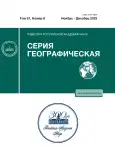Energy Efficiency Assessment of the Upper Volga and Kama Cascades of Reservoirs at the Beginning of the 21st Century
- Autores: Yasinsky S.V.1, Sobol I.S.2, Khokhlov D.N.2, Fasakhov M.A.3, Shaydulina A.A.3
-
Afiliações:
- Institute of Geography RAS
- Nizhny Novgorod State University of Architecture and Civil Engineering
- Perm State University
- Edição: Volume 87, Nº 6 (2023)
- Páginas: 835-846
- Seção: ИСПОЛЬЗОВАНИЕ ВОДНЫХ РЕСУРСОВ
- URL: https://journals.rcsi.science/2587-5566/article/view/148126
- DOI: https://doi.org/10.31857/S2587556623060146
- EDN: https://elibrary.ru/APSVIX
- ID: 148126
Citar
Texto integral
Resumo
Basic information about the Upper Volga and Kama cascades of reservoirs is presented: water surface area, full and useful volume capacity, and average project power generation. The contribution of the considered cascades to the power generation of the entire Volga−Kama cascade of reservoirs is estimated. Data series have been generated on the annual inflow, discharge of water through hydroelectric facilities, and generation of electricity from 2002 to 2021, for several stations from 2004 to 2022. The relationship between the area of reservoirs and their capacity is shown, as well as the generation of electricity with the water content of individual years and periods. A relationship has been established between the inflow of water into the reservoirs and its discharge through the turbines of the hydroelectric power plants. Particular attention is paid to the Rybinsk reservoir, which performs over-year water storage. The generation of electricity in high-water, medium-water, and low-water years is calculated. The deviation of the actual electricity generation from the average design was estimated, based on which a conclusion was made about the efficiency of the hydroelectric power plants. The probability of electricity generation is determined depending on the predicted values of the river runoff.
Sobre autores
S. Yasinsky
Institute of Geography RAS
Autor responsável pela correspondência
Email: yasisergej@yandex.ru
Russia, Moscow
I. Sobol
Nizhny Novgorod State University of Architecture and Civil Engineering
Email: yasisergej@yandex.ru
Russia, Nizhny Novgorod
D. Khokhlov
Nizhny Novgorod State University of Architecture and Civil Engineering
Email: yasisergej@yandex.ru
Russia, Nizhny Novgorod
M. Fasakhov
Perm State University
Email: yasisergej@yandex.ru
Russia, Perm
A. Shaydulina
Perm State University
Email: yasisergej@yandex.ru
Russia, Perm
Bibliografia
- Авакян А.Б. Народнохозяйственные и экологические последствия спуска водохранилищ // Гидротехн. стр-во. 1991. № 8. С. 1–8.
- Водохранилища Верхней Волги / рук. В.С. Дементьев. Нижний Новгород: Верхне-Волжское БВУ, 2008. 156 с.
- Евстигнеев В.М. Современный гидроэнергетический потенциал и тенденции его использования // Прогноз климатической ресурсообеспеченности Восточно-Европейской равнины в условиях потепления ХХI века. М.: Макс-Пресс, 2008. С. 175–183.
- Захаров А.В., Алексеев И.А. Социально-экологические проблемы Чебоксарского водохранилища // Изв. РАН. Сер. геогр. 2012. № 5. С. 90–101.
- Левит-Гуревич Л.К. Рациональное управление водными ресурсами водохранилищ на примере Волжско-Камского каскада // Изв. Самарского науч. центра РАН. 2012. № 1 (9). С. 2343–2354.
- Малик Л.К. Факторы риска повреждения гидротехнических сооружений. Проблемы безопасности. М.: Наука, 2005. 354 с.
- Мирзоев М.И., Слива И.В. Проект строительства Красногорских малых ГЭС на р. Кубань // Гидротехника. 2019. № 3 (56). С. 8–11.
- Научно-прикладной справочник Многолетние колебания и изменчивость водных ресурсов и основных характеристик стока рек Российской Федерации / под ред. В.Ю. Георгиевского. СПб.: ООО “РИАЛ”, 2021. 190 с.
- Научно-прикладной справочник: Многолетние характеристики притока воды в крупнейшие водохранилища / под ред. В.Ю. Георгиевского. СПб.: “ООО РПЦ Офорт”, 2017. 132 с.
- Орехов В.Ф., Краснов А.Н. Проблемы Чебоксарского водохранилища // Астраханской вестн. экологического образования. 2013. № 3 (25). С. 170–184.
- Правила использования водных ресурсов Камского и Воткинского водохранилищ на р. Каме. М.: Федеральное агентство водных ресурсов, 2016. 202 с.
- Правила использования водных ресурсов Нижнекамского водохранилища на р. Каме. М.: Федеральное агентство водных ресурсов, 2014. 132 с.
- Ресурсы поверхностных и подземных вод, их использование и качество (Справочное издание). СПб., 2021. 153 с.
- Эдельштейн К.К. Водохранилища России: экологические проблемы, пути их решения. М.: ГЕОС, 1998. 277 с.
Arquivos suplementares















